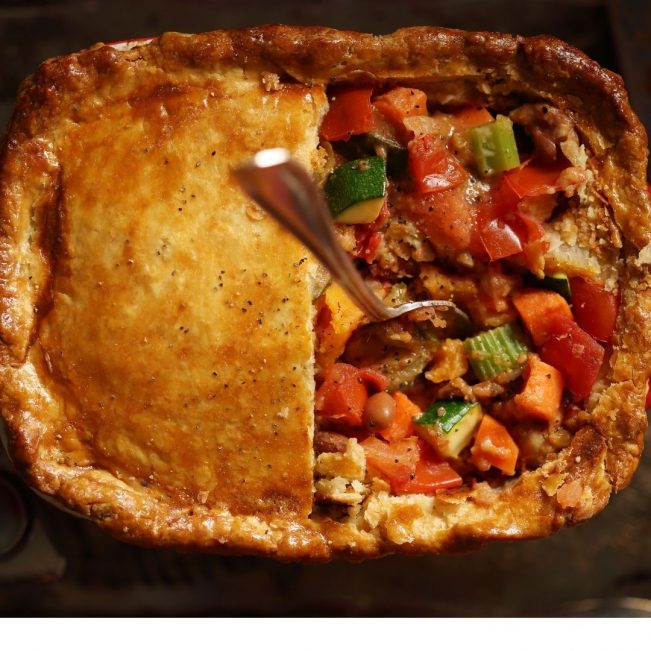Winter can be both dark and fairly limiting in terms of seasonal veggies. This makes it a great time of year to cook food for eye health and use frozen vegetables.
Did you make a “yuck” face? There is NO NEED to fear frozen fruit or vegetables! Frozen is a great choice. They are harvested and frozen at the peak of freshness, so they often deliver more nutrition than “fresh” produce that is stored, distributed, and sold at ambient temperature.
Some of our favorite veggies to grab from the freezer section are spinach, peas, and corn. It just so happens, these veggies are high in lutein and zeaxanthin: the two most important carotenoids in food for eye health.
Good Food for Eye Health Contains Lutein and Zeaxanthin
Lutein and zeaxanthin are powerful antioxidants found in the macula of the eye. Not only do they repair oxidative damage caused by age and sun, together, they make up macular pigment; a yellow pigment that acts as blue-light protection [1]. Through these mechanisms, lutein and zeaxanthin have been shown to reduce the risk of age-related macular degeneration and cataract development [1].
If you would like to read more about taking these antioxidants in supplement form, check out the information page associated with Metabolic Maintenance’s VitalEyes Complete Ocular formula.
While we need both lutein and zeaxanthin to make macular pigment, lutein is typically more plentiful in the diet than zeaxanthin.
The foods highest in lutein are leafy greens and brassica, such as spinach, kale, broccoli, lettuce, parsley, and cilantro [2]. The foods highest in zeaxanthin are orange bell peppers and yellow corn [2].
More lutein and zeaxanthin can be absorbed from these foods when they are cooked, as heat denatures plant proteins that the human digestive system cannot, releasing nutrients that would otherwise be sequestered away. Chicken egg yolks are an excellent source of both nutrients, and their high-fat content makes their lutein and zeaxanthin content 3x more bioavailable than that in vegetables [1].
This “pot pie” recipe is not made with a traditional crust but contains all of the hearty comforts of a pot pie filling. The food for eye health in the recipe has been selected for lutein content, and in lieu of a crust, it’s topped with a zeaxanthin-rich cornbread layer.
It can easily be made vegetarian by adding more of your favorite veggies instead of chicken and using vegetable broth. If you are gluten-free, try substituting our cornbread recipe with a gluten-free cornbread mix and replacing the flour in the filling with cornstarch or a 1-to-1 GF flour blend.
Ingredients (serves 6-8)
For the cornbread crust:
3/4 cup yellow cornmeal (531 μg/100 g zeaxanthin)
3/4 cup all-purpose flour
1 1/2 teaspoons baking powder
1/2 teaspoon baking soda
1/2 teaspoon kosher salt
2 large eggs (237 μg/100 g lutein; 216 μg/100 g zeaxanthin)
¼ cup honey
¼ cup olive oil
1 cup greek yogurt
1 bunch green onions chopped (2,488 μg/100 g zeaxanthin)
For the filling:
2 tablespoons (roughly) olive oil
1 yellow onion chopped
3 cloves garlic finely chopped
2 large carrots peeled and chopped (358 μg/100 g lutein)
1 zucchini roughly chopped (1,355 μg/100 g lutein)
½ tsp salt
1 cup frozen spinach defrosted and drained well (12,640 μg/100 g lutein)
1 cup frozen peas defrosted (1,350 μg/100 g lutein)
2 chicken breasts cooked and chopped (rotisserie chicken works great)
½ cup flour
3 cups chicken broth
¼ cup greek yogurt
½ tsp dried thyme
½ tsp turmeric
black pepper to taste
2 tbsp fresh parsley chopped (4,326 μg/100 g lutein)
*lutein and zeaxanthin concentrations [1].
Instructions
Preheat the oven to 350F.
Start by making the cornbread batter. In a large bowl, mix together flour, cornmeal, baking soda, baking powder, and salt. Make a little well in the center and add the yogurt, eggs, honey, and oil into the well.
Beat the eggs into liquids first, and then combine with the rest of the dry ingredients. Last, stir in the chopped green onions. Set the batter aside while preparing the pie filling.
In a large dutch oven, heat olive oil on medium-high. Add onions, carrots, zucchini, and salt. Saute until onions are translucent (about 5 minutes).
Add garlic, spinach, and peas, and saute for 2 more minutes.
Stir in chicken. When veggies and chicken are homogenous, sprinkle 1/2 cup flour over the whole mixture and stir again to coat evenly. Then add the chicken broth and stir until thickened (about 5 mins).
Once thickened, add greek yogurt, spices, and herbs, and stir until incorporated.
Turn off the stove and gently spoon the cornbread batter onto the still-bubbling surface of the chicken and veggie filling. The batter should cover the surface of the filling, forming a thick layer. Put the pot into the preheated oven. Bake for 30 minutes, or until the cornbread layer is golden brown at the edges.
Let cool for a few minutes (10-20) before serving. Cornbread will cool, but the filling will stay hot, insulated by the baked layer above. Use a large serving spoon to serve cornbread and filling into shallow bowls.
References
- Abdel-Aal, El-Sayed M., et al. “Dietary sources of lutein and zeaxanthin carotenoids and their role in eye health.” Nutrients 5.4 (2013): 1169-1185.
- Perry, Alisa, Helen Rasmussen, and Elizabeth J. Johnson. “Xanthophyll (lutein, zeaxanthin) content in fruits, vegetables and corn and egg products.” Journal of food Composition and Analysis 22.1 (2009): 9-15.
